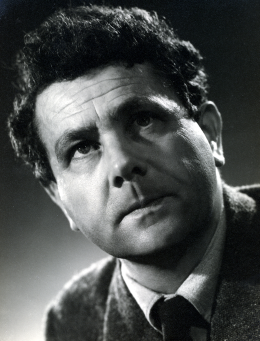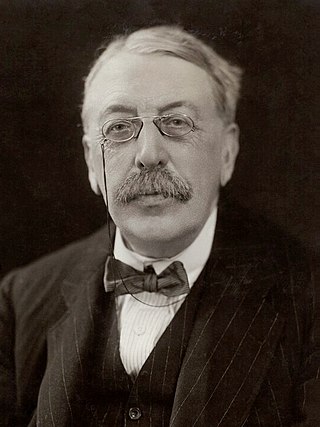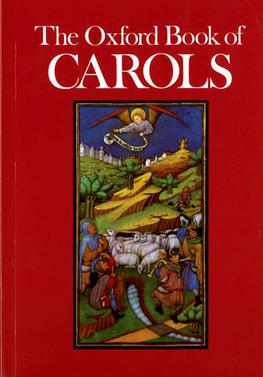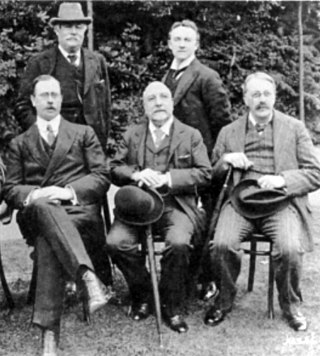Related Research Articles

Gerald Raphael Finzi was a British composer. Finzi is best known as a choral composer, but also wrote in other genres. Large-scale compositions by Finzi include the cantata Dies natalis for solo voice and string orchestra, and his concertos for cello and clarinet.

Sir Charles Villiers Stanford was an Anglo-Irish composer, music teacher, and conductor of the late Romantic era. Born to a well-off and highly musical family in Dublin, Stanford was educated at the University of Cambridge before studying music in Leipzig and Berlin. He was instrumental in raising the status of the Cambridge University Musical Society, attracting international stars to perform with it.
The folk music of England is a tradition-based music which has existed since the later medieval period. It is often contrasted with courtly, classical and later commercial music. Folk music traditionally was preserved and passed on orally within communities, but print and subsequently audio recordings have since become the primary means of transmission. The term is used to refer both to English traditional music and music composed or delivered in a traditional style.

Charles Wood was an Irish composer and teacher; his students included Ralph Vaughan Williams at Cambridge and Herbert Howells at the Royal College of Music. He is primarily remembered and performed as an Anglican church music composer, but he also wrote songs and chamber music, particularly for string quartet.
John Lloyd Williams was a Welsh botanist, author, and musician. He was one of the founders of the Welsh Folk-Song Society, established in 1906 to promote the collection and study of traditional Welsh folk songs, and became the first editor of the society's journal.
English Folk Song Suite is one of English composer Ralph Vaughan Williams' most famous works. It was first published for the military band as Folk Song Suite and its premiere was given at Kneller Hall on 4 July 1923, conducted by Lt Hector Adkins. The piece was then arranged for full orchestra in 1924 by Vaughan Williams' student Gordon Jacob and published as English Folk Song Suite. The piece was later arranged for British-style brass band in 1956 by Frank Wright and published as English Folk Songs Suite. All three versions were published by Boosey & Hawkes; note the use of three different titles for the three different versions. The suite uses the melodies of nine English folk songs, six of which were drawn from the collection made by Vaughan Williams’ friend and colleague Cecil Sharp.
Boosey & Hawkes is a British music publisher, purported to be the largest specialist classical music publisher in the world. Until 2003, it was also a major manufacturer of brass, string and woodwind musical instruments.
"Arthur McBride" is a folk song probably of Irish origin, also found in England, Scotland, Australia, and North America. Describing a violent altercation with a recruiting sergeant, it can be narrowly categorized as an "anti-recruiting" song, a specific form of anti-war song, and more broadly as a protest song. A. L. Lloyd described it as "that most good-natured, mettlesome, and un-pacifistic of anti-militarist songs".

Martin Edward Fallas Shaw was an English composer, conductor, and theatre producer. His over 300 published works include songs, hymns, carols, oratorios, several instrumental works, a congregational mass setting, and four operas including a ballad opera.

The Oxford Book of Carols is a collection of vocal scores of Christmas carols and carols of other seasons. It was first published in 1928 by Oxford University Press and was edited by Percy Dearmer, Martin Shaw and Ralph Vaughan Williams. It became a widely used source of carols among choirs and church congregations in Britain.
Christopher Norton is a British pianist and composer of Jazz music. His pieces are standard in piano learning repertoire, especially the ABRSM and RCM.
Frederick John Thurston was an English clarinettist.

John Alexander Fuller Maitland was an influential British music critic and scholar from the 1880s to the 1920s. He encouraged the rediscovery of English music of the 16th and 17th centuries, particularly Henry Purcell's music and English virginal music. He also propounded the notion of an English Musical Renaissance in the second half of the 19th century, particularly praising Charles Villiers Stanford and Hubert Parry.

Geoffrey Turton Shaw was an English composer and musician specialising in Anglican church music. After Cambridge, where he was an organ scholar, he became a schoolmaster, then a schools inspector, while producing a stream of compositions, arrangements, and published collections of music. He was awarded the Lambeth degree of Doctor of Music.

The English Musical Renaissance was a hypothetical development in the late 19th and early 20th century, when British composers, often those lecturing or trained at the Royal College of Music, were said to have freed themselves from foreign musical influences, to have begun writing in a distinctively national idiom, and to have equalled the achievement of composers in mainland Europe. The idea gained considerable currency at the time, with support from prominent music critics, but from the latter part of the 20th century has been less widely propounded.
The British folk revival incorporates a number of movements for the collection, preservation and performance of folk music in the United Kingdom and related territories and countries, which had origins as early as the 18th century. It is particularly associated with two movements, usually referred to as the first and second revivals, respectively in the late 19th to early 20th centuries and the mid-20th century. The first included increased interest in and study of traditional folk music, the second was a part of the birth of contemporary folk music. These had a profound impact on the development of British classical music and in the creation of a "national" or "pastoral" school and led to the creation of a sub-culture of folk clubs and folk festivals as well as influential subgenres including progressive folk music and British folk rock.
Peter Gregory Rose is a conductor, composer, arranger, and music director. He has conducted orchestral, choral and ensemble premieres throughout Europe and the Far East.
St. Columba is a traditional Irish tune. It was first published by George Petrie in 1855, and it was republished in Charles Villiers Stanford's edited compilation of the tunes Petrie collected. It was described as having been "sung on the dedication of a chapel" in County Londonderry. The tune was paired with the hymn The King of Love My Shepherd Is in The English Hymnal (1906), and it rose in popularity with the hymn.

Benjamin Britten's Five Flower Songs, Op. 47, is a set of five part songs to poems in English by four authors which mention flowers, composed for four voices (SATB) in 1950 as a gift for the 25th wedding anniversary of Leonard and Dorothy Elmhirst. It was first performed in the open air at the couple's estate Dartington Hall, with Imogen Holst conducting a student choir. The set has been frequently recorded by English and foreign chamber choirs and ensembles, including Polyphony, Cambridge Singers and the RIAS Kammerchor.
Yvonne Madeleine Adair was a pianist, teacher and composer whose educational compositions still regularly appear in the graded pieces of music college examination boards. Some pieces were published under the pen name Ella Fairall.
References
- 1 2 Shepherd, J. (2003). Continuum encyclopedia of popular music of the world. Volume 1, Volume 1. London, Continuum
- ↑ Knevett, Arthur. (2014) "Cultural and political origins of the folk-song society and the Irish dimension." The Free Library 30 November 2014.
- ↑ Dibble, Jeremy (2002) Charles Villiers Stanford: Man and Musician, Oxford University Press
- ↑ Cox, G. (1992). Towards the National Song Book: The History of an Idea. British Journal of Music Education, 9(03), 239-253.